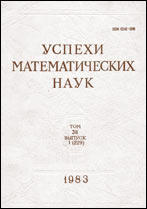|
This article is cited in 7 scientific papers (total in 8 papers)
Markov representations of stochastic systems
E. B. Dynkin
Abstract:
A great deal of research into the theory of random processes is concerned with the problem of constructing a process that has certain properties of regularity of the trajectories and has the same finite-dimensional probability distribution as a given stochastic process $x_t$. It is a complicated theory and one that is difficult to apply to those properties that we most need for the study of Markov processes (the strict Markov property, standardization, and the like.)
The problem can be usefully reformulated. In an actual experiment we do not observe the state $x_t$ at a fixed instant $t$, but rather events that occupy certain time intervals. This is the motivation behind the Gel'fand–Itô theory of generalized random processes. Kolmogorov, in 1972, proposed an even more general concept of a stochastic process as a system of $\sigma$-algebras $\mathscr F(I)$ labelled by time intervals $I$. Developing this approach, we introduce the concept of a Markov representation $x_t$ of the stochastic system $\mathscr F(I)$ and prove the existence of regular representations. We construct two dual regular representations (the right and the left), which we then combine into a single Markov process by two methods, the “vertical” and the “horizontal” method. We arrive at a general duality theory, which provides a natural framework for the fundamental results on entry and exit spaces, excessive measures and functions, additive functionals, and others. The initial steps in the construction of this theory were taken in [6]. The note [5] deals with applications to additive functionals (detailed proofs are in preparation). We consider random processes defined in measurable spaces without any topology: the introduction of a reasonable topology allows of a certain arbitrariness. The relation between our definitions of regularity and more traditional properties stated in topological terms (continuity from the right, the existence of a limit from the left, etc.) are considered in the Appendix, which is written by S. E. Kuznetsov.
Received: 26.03.1974
Citation:
E. B. Dynkin, “Markov representations of stochastic systems”, Russian Math. Surveys, 30:1 (1975), 65–104
Linking options:
https://www.mathnet.ru/eng/rm4127https://doi.org/10.1070/RM1975v030n01ABEH001401 https://www.mathnet.ru/eng/rm/v30/i1/p61
|


|




 Contact us:
Contact us: Terms of Use
Terms of Use
 Registration to the website
Registration to the website Logotypes
Logotypes








 Citation in format
Citation in format 
